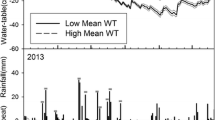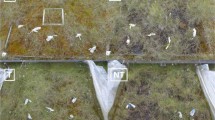Abstract
Following ecosystem-scale restoration of a post-harvested bog in Eastern Canada, a long term monitoring program was set up. Peat, water and plant chemistry data were collected during 7 years in a restored peatland, an adjoining post-harvested non-restored peatland, and in a neighboring natural peatland to determine the potential of chemistry data for evaluating of restoration success over time. We used a multivariate Principal Response Curves (PRC) approach to study the temporal evolution of peat, water, and plant tissue chemistry. Nitrogen, iron, and sodium were the most responsive elements to restoration in the peat. Water chemistry was still different between natural and restored sections 7 years after restoration, but the difference was not constant over the growing season. The analyses of plant tissue chemistry provided useful information related to fundamental processes (nutrient retention/leaching, plant nutrition). Among other, it highlighted P deficiencies in the non-restored section, and nutrient replenishment in the restored plant tissues. P levels appear to be a good indicator of restoration success and should be used routinely in monitoring studies. Since the three plants species tested in this study displayed different responses to restoration, we also recommend targeting key species or functional groups for monitoring.







Similar content being viewed by others
References
Adamson JK, Scott WA, Rowland AP, Beard GR (2001) Ionic concentrations in a blanket bog in northern England and correlations with deposition and climate variables. European Journal of Soil Science 52:69–79
Amacher MC, Henderson RE, Breithaupt MP, Seale CL, LaBauve JM (1990) Unbuffered and buffered salt methods for exchangeable cations and effective cation-exchange capacity. American Journal of Soil Science 54:1036–1042
Andersen R, Francez A-J, Rochefort L (2006) The physicochemical and microbial status of a restored bog in Québec: identification of relevant criteria to monitor success. Soil Biology & Biochemistry 38:1375–1387
Bayley SE, Behr RS, Kelly CA (1986) Retention and release of S from a freshwater wetland. Water, Air and Soil pollution 31:101–114
Bedford BL, Walbridge MR, Aldous A (1999) Patterns in nutrient availability and plant diversity in temperate North American wetlands. Ecology 80:2151–2169
Bray RL, Kurtz LT (1945) Determination of total organic and available forms of phosphorus in soils. Soil Science 59:39–45
Clymo RS (1963) Ion echange in Sphagnum and its relation to bog ecology. Annales Botanicae 27:309–324
Croft M, Rochefort L, Beauchamp CJ (2001) Vacuum-extraction of peatlands disturbs bacterial population and microbial biomass carbon. Applied Soil Ecology 18:1–12
Damman AWH (1978) Distribution and movement of element in ombrotrophic peat bogs. Oikos 30:480–495
Environment Canada. (2004). Daily Data Report. http://www.climate.weatheroffice.ec.gc.ca/climateData/dailydata_f.html. Accessed 6 June 2007
Erhenfeld JG (2001) Defining the limit of restoration: the need for realistic goals. Restoration Ecology 8:2–9
Gerdol R (1991) Seasonal variations in the element concentrations in mire water and in Sphagnum mosses on an ombrotrophic bog in the Southern Alps. Lindbergia 16:44–50
Gorham E, Rochefort L (2003) Peatland restoration: a brief assessment with special reference to Sphagnum bogs. Wetland Ecology and Management 11:109–119
Groeneveld EVG, Rochefort L (2005) Polytrichum strictum as a solution to frost heaving in disturbed ecosystems: a case study with milled peatlands. Restoration Ecology 13:74–82
Isselin-Nondedeu F, Rochefort L, Poulin M (2007) Long-term vegetation monitoring to assess the restoration success of a vacuum-mined peatland (Québec, Canada). Fédération des conservatoires d’espaces naturels/Pôle relais tourbières, International conference “Peat and Peatlands 2007” 23:153–166
Jonasson S, Shaver GR (1999) Within-stand nutrient cycling in arctic and boreal wetlands. Ecology 80:2139–2150
Keeney DR, Nelson DW (1982) Nitrogen-inorganic forms. In: Page AL, Miller RH, Keeney DR (eds) Methods of soil analysis- Part 2. Chemical and microbiological properties (2nd ed) Madison, pp 643–698
Lachance D, Lavoie C (2004) Vegetation of Sphagnum bogs in highly disturbed landscapes: relative influence of abiotic and anthropogenic factors. Applied Vegetation Science 7:183–192
Laiho R, Pentila T, Laine J (2004) Variation in soil nutrient concentrations and bulk density within peatland forest sites. Silva Fennica 38:29–41
Lavoie C, Zimmermann C, Pellerin S (2001) Peatland restoration in southern Québec (Canada): a paleoecological perspective. Écoscience 8:247–258
Lepš PJ, Šmilauer P (2003) Multivariate analysis of ecological data using CANOCO. Cambridge University Press, UK
Li Y, Vitt DH (1995) The dynamics of moss establishment: temporal responses to a moisture gradient. Journal of Bryology 18:677–687
Limpens J, Berendse F, Klees H (2004) How phosphorus availability affects the impact of nitrogen deposition on Sphagnum and vascular plants in bogs. Ecosystems 7:793–804
Maccherini S, Marignani M, Castagnini P, Van den Brink PJ (2007) Multivariate analysis of the response of overgrown semi-natural calcareous grasslands to restorative shrub cutting. Basic and Applied Ecology 8:332–342
Malcolm DC, Cuttle SP (1983) The application of fertilizers to drained peat. 1. Nutrient losses in drainage. Forestry 56:155–174
Mazerolle M, Poulin M, Lavoie C, Rochefort L, Desrochers A, Drolet B (2006) Animal and vegetation patterns in natural and man-made bog pools: implication for restoration. Freshwater Biology 51:333–350
Ormerod SJ (2003) Restoration in applied ecology: editor’s introduction. Journal of Applied Ecology 40:44–50
Pakeman RJ (2004) Consistency of plant species and trait responses to grazing along a productivity gradient: a multi-site analysis. Journal of Ecology 92:893–905
Proctor MCF (1994) Seasonal and shorter-term changes in surface-water chemistry on four English ombrogenous bogs. Journal of Ecology 82:597–610
Proctor MCF (2006) Temporal variation in the surface-water chemistry of a blanket bog on Dartmoor, southwest England: analysis of 5 year’s data. European Journal of Soil Science 57:167–178
Prévost M, Plamondon AP, Belleau P (1999) Effects of drainage of a forested peatland on water quality and quantity. Journal of Hydrology 214:130–143
Price JS, Heathwaite AL, Baird AJ (2003) Hydrological processes in abandoned and restored peatlands: an overview of management approaches. Wetland Ecology and Management 11:65–83
Quinty F, Rochefort L (2003) Guide de restauration des tourbières, 2e édition. Canadian Sphagnum Peat Moss Association and New Brunswick Department of Natural Resources and Energy, Québec
Read DJ (1996) The structure and function of the ericoid mycorrhizal root. Annales Botanicae 77:365–374
Renou F, Jones S, Farrell EP (2000) Leaching of phosphorus fertiliser applied on cutaway peatland forests recently established in central Ireland. Pour une gestion harmonieuse des tourbières. Proceedings of the 11th International Peat Congress, Volume II. Québec
Rochefort L (2001) Restauration écologique. In: Payette S, Rochefort L (eds) Écologie des tourbières du Québec-Labrador. Les Presses de l’Université Laval, Québec, pp 449–505
Rochefort L, Quinty F, Campeau S, Jonhson K, Malterer T (2003) North American approach to the restoration of Sphagnum dominated peatlands. Wetlands Ecology and Management 11:3–20
Schauffler M, Jacobson GL Jr, Pugh AL IV, Norton SA (1996) Influence of vegetation structure on capture of salt and nutrient aerosols in a Maine peatland. Ecological Applications 6:263–268
Selmer-Olsen AR, Oein A (1973) Determination of chloride in aqueous soil extracts and water samples by means of a chloride-selective electrode. Analyst 98:412–415
Shantz MA, Price JS (2006) Hydrological changes following restoration of the Bois-des-Bel peatland, Quebec, 1999–2002. Journal of Hydrology 341:543–553
Shaver GR, Chapin FS III (1980) Response to Fertilization by various plant growth forms in an Alaskan Tundra: nutrient accumulation and growth. Ecology 61:662–675
Sjörs H (1950) On the relation between vegetation and electrolytes in North Swedish mire waters. Oikos 2:241–259
Sottocornola M, Boudreau S, Rochefort L (2007) Peat bog restoration: effect of phosphorus on plant re-establishment. Ecological Engineering 31:29–40
Ter Braak CJF (1988) CANOCO—an extension of DECORANA to analyse species environment relationships. Vegetatio 75:159–160
Urban NR, Gorham E, Underwood JK, Martin FB, Ogden JG III (1990) Geochemical processes controlling concentrations of Al., Fe, and Mn in Nova Scotia Lakes. Limnology and Oceanography 35:1516–1534
van den Brink PJ, Ter Braak CJF (1998) Multivariate analysis of stress in experimental ecosystems by principal response curves and similarity analysis. Aquatic Ecology 32:163–178
van den Brink PJ, Ter Braak CJF (1999) Principal response curves: analysis of time-dependent multivariate responses of biological community to stress. Environmental Toxicology and Chemistry 18:138–148
van Duren IC, Boeyer D, Grootjans AP (1997) Nutrient limitations in an extant and drained poor fen: implications for restoration. Plant Ecology 133:91–100
Vandvik V, Heegaard E, Måren EI, Aarrestad P (2005) Managing heterogeneity: the importance of grazing and environmental variation on post-fire succession in heathlands. Journal of Applied Ecology 42:139–149
Vitt DH, Chee WL (1990) The relationship of vegetation to surface water chemistry and peat chemisitry in fens of Alberta, Canada. Vegetatio 89:87–106
Vitt DH, Bayley SE, Tai-Long J (1995) Seasonal variation over a bog-rich fen gradient in Continental Western Canada. Canadian Journal of Fisheries and Aquatic Sciences 52:587–606
Waddington JM, McNeil P (2002) Peat oxidation in an abandoned vaccum extracted peatland. Canadian Journal of Soil Science 82:279–286
Waddington JM, Thòt K, Bourbonniere R (2008) Dissolved organic carbon export from a cutover and restored peatland. Hydrological Processes 22:2215–2224
Wheeler BD, Shaw SC (1995) Restoration of Damaged Peatlands (with particular reference to lowland raised bogs affected by peat extraction). Department of the Environment, University of Sheffield, UK
Wind-Mulder HL, Rochefort L, Vitt DH (1996) Water and peat chemistry comparison of natural and post-harvested peatlands across Canada and their relevance to peatland restoration. Ecological Engineering 7:161–181
Wojtun B (1994) Element contents of Sphagnum mosses of peat bogs of lower Silesia (Poland). The Bryologist 97:284–995
Zoltai SC, Vitt DH (1995) Canadian wetlands: environmental gradients and classification. Vegetatio 188:131–137
Acknowledgements
We thank Suzanne Campeau, Claire Boismenu, Stéphanie Boudreau and Rémy Pouliot for assistance in the field, Alain Brousseau for laboratory chemical analyses, and anonymous reviewers for helpful comments. This project was funded by NSERC as part of the Industrial Research Chair in Peatland management, and with a NSERC scholarship to RA.
Author information
Authors and Affiliations
Corresponding author
Rights and permissions
About this article
Cite this article
Andersen, R., Rochefort, L. & Poulin, M. Peat, Water and Plant Tissue Chemistry Monitoring: A Seven-Year Case-Study in a Restored Peatland. Wetlands 30, 159–170 (2010). https://doi.org/10.1007/s13157-009-0015-0
Received:
Accepted:
Published:
Issue Date:
DOI: https://doi.org/10.1007/s13157-009-0015-0




